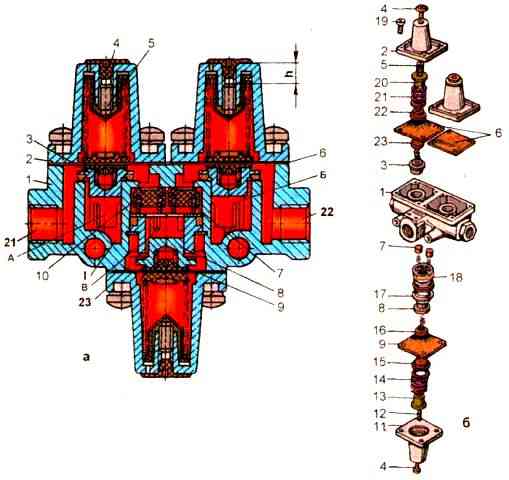The triple safety valve (Fig. 1) performs the following functions:
- - divides the air line coming from the compressor into two main and one additional circuit;
- - automatically turns off one of the circuits in case of damage or loss of its tightness; maintains compressed air pressure in undamaged circuits and ensures they are replenished with air from the compressor;

- - maintains tightness in all undamaged circuits in case of damage or loss of tightness of the supply line; feeds an additional circuit from both main circuits.
Disassembling and assembling the valve
To disassemble the triple protective valve, it must be clamped in a vice with soft jaws by the mounting bosses, loosen the screws 19 securing the upper protective covers 2, and then, holding them with your hand, unscrew the screws 19 and remove one and then the other covers.
If the protective covers are not removed by themselves under the action of springs 21, light tapping on them with a copper or wooden hammer is allowed.
The remaining parts of the valves 3 and the membrane 6 can be easily removed from the body

To disassemble the valve of the additional circuit, body 1 must be turned 180° in a vice and clamped.
Then unscrew the screws, remove cover 11 and remove valve 8 with spring 14, guide 13, plate 15 and membrane 9.
Check valves 7 are removed from body 1 after dismantling the thrust ring 17 using special round-nose pliers.
Cracks, hairlines and other defects visible to the eye are not allowed on the surface of body parts.
Parts must be cleaned of rust and burnt marks. All rubber parts must be replaced with new ones.
The order of assembling the triple safety valve is the reverse of disassembly.
Assembly of valves, rubber O-rings and other rubber parts must be done carefully to avoid damaging them.
The presence of scratches, cuts and other defects on the surface of these parts is not allowed.
Adjusting screws 5 before adjustment during assembly must be screwed into the covers to a depth of 9 mm from the top plane of the covers.
Adjusting and checking the triple safety valve
Install the safety valve in threes on the test bench and connect according to the diagram shown in (Fig. 3).
Then apply and release air three times into outlet 1 at a pressure of 0.75 MPa.

Adjust the bypass pressure of the main circuits by supplying air at a pressure of 0.56 MPa to terminal 1, then gradually unscrew the adjusting screw 5 (see Fig. 1), first in the water circuit until pressure appears in terminal 21, then in the other circuit until pressure appears in terminal 22.
To adjust the pressure in the additional circuit, you need to supply air to terminal 21 or 22 at a pressure of 0.51 MPa and gradually turn out the adjusting screw of the additional circuit until pressure appears in terminal 23.
After adjusting the triple safety valve, you need to fix the adjusting screws 5 with paint and close them with rubber plugs 4.
To check the tightness of the triple safety valve, air must be supplied to terminal 1 at a pressure of 075 MPa. the pressure in terminals 21, 22 and 23 should become equal to the pressure in terminal 1
Bleed the air from terminal 1, and the pressure in terminals 21, 22 and 23 should not drop.
Then bleed air from terminals 21 or 22, and the pressure in terminals 23, 21 or 22 should not drop.
Next, you need to re-establish the pressure of 0.75 MPa in terminals 1, 21, 22 and 23 and release air from terminal 23, while the pressure in terminals 1, 21 and 22 should not fall below 0.42 MPa.
Check the tightness of the triple safety valve by saponifying.





